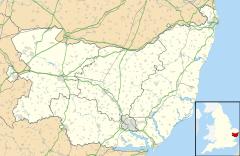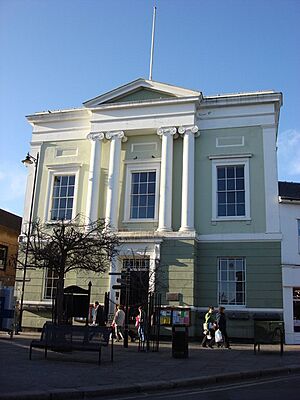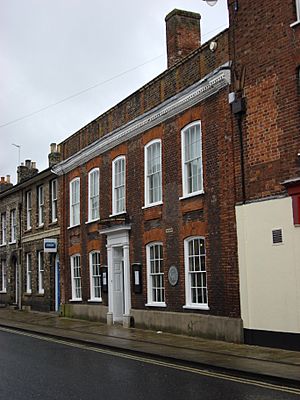Sudbury, Suffolk facts for kids
Quick facts for kids Sudbury |
|
|---|---|
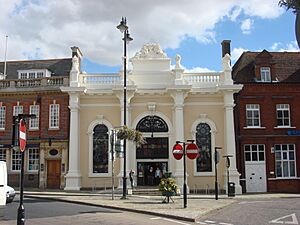 The Corn Exchange |
|
| Area | 7.013 km2 (2.708 sq mi) |
| Population | 23,912 (2021 census) |
| • Density | 3,410/km2 (8,800/sq mi) |
| OS grid reference | TL8741 |
| Civil parish |
|
| District |
|
| Shire county | |
| Region | |
| Country | England |
| Sovereign state | United Kingdom |
| Post town | SUDBURY |
| Postcode district | CO10 |
| Dialling code | 01787 |
| Police | Suffolk |
| Fire | Suffolk |
| Ambulance | East of England |
| EU Parliament | East of England |
| UK Parliament |
|
Sudbury is a busy market town in Suffolk, England. It sits by the River Stour, close to the border with Essex. Sudbury is about 60 miles (97 km) north-east of London. It is the biggest town in the Babergh area. In 2021, about 23,912 people lived here.
Sudbury has a long history, going back to the time of the Anglo-Saxons. It became a market town in the early 1000s. The town grew rich from making textiles, especially wool, in the Late Middle Ages. This wealth helped build many of its old churches and buildings.
In the 1700s, Sudbury became known for its art. It is the birthplace of the famous painter Thomas Gainsborough. His beautiful landscape paintings inspired another well-known Suffolk artist, John Constable. The railway arrived in the 1800s, connecting Sudbury to other places. During World War II, American bombers used an airfield near the town.
Today, Sudbury still has its market twice a week in the town centre. St Peter's Church is now a place for concerts and art shows. The town also has a semi-professional football team, A.F.C. Sudbury. You can visit Gainsborough's House museum to learn about the artist.
Contents
A Look at Sudbury's History
How Old is Sudbury?
Sudbury's story begins a very long time ago, in the age of the Saxons. The town was first mentioned around the year 799. Back then, it was called Suðberie, which means "south-borough." This name probably helped people tell it apart from towns like Norwich or Bury St Edmunds to the north.
The town is also mentioned in the Domesday Book from 1086. This book recorded information about England after the Norman Conquest. It showed Sudbury as a place where people came to trade their goods. The market officially started in 1009. Around this time, Sudbury had a defensive ditch and a changed part of the River Stour to protect it.
Churches and Priories in Early Sudbury
Many important religious buildings were built in Sudbury. The Church of All Saints was started in the 1100s. Later, a monk named Adam bought it and gave it to the Abbey of St Albans. Two other religious places, St Bartholemew's Benedictine Priory and the Chapel of Holy Sepulchre, also began in the 1100s.
A group of Dominican monks set up Sudbury Priory in the mid-1200s. This priory grew over time and was one of three Dominican priories in Suffolk. A hospital for people with leprosy was also built outside the town in 1272.
Sudbury's Wool and Wealth
Sudbury was one of the first towns where Edward III encouraged people from Flanders (now part of Belgium) to settle. These skilled workers helped the weaving and silk industries grow. This made Sudbury very rich for many centuries during the Late Middle Ages.
Because of this wealth, many grand houses and churches were built. The Woolsack in the House of Lords (part of the UK Parliament) was once stuffed with wool from the Sudbury area. This shows how important the wool industry was and how much money people in Sudbury had.
Simon Sudbury: A Local Hero or Villain?
One famous person from Sudbury was Archbishop Simon Sudbury. He was a very important leader, serving as the Archbishop of Canterbury and even as Lord Chancellor of England. However, he became unpopular because he created a new tax called the poll tax.
In 1381, during the Peasants' Revolt, rebellious peasants broke into the Tower of London. Simon Sudbury was taken out and beheaded. His body is buried in Canterbury Cathedral, but his skull is kept in St Gregory's Church in Sudbury. Simon cared about his hometown. He helped found St Leonard's Hospital in 1372 for people needing care. He also started the College of St Gregory in 1375 to support priests.
Life in Sudbury: 1500s to 1700s
From the 1500s to the 1700s, the weaving industry had its ups and downs. Sudbury had times of great success and times when things were harder. The town's leaders, the mayor and corporation, managed the town's affairs. They built a place in 1624 for people who were homeless or causing trouble. They also tried to fix Ballingdon Bridge after a storm destroyed it in 1594.
During the English Civil War, a group of 12 watchmen was formed. Their job was to protect the town from enemies, who were thought to be supporters of the King.
Sudbury and the area around it were strong centres for Puritan beliefs in the 1600s. Many families from Sudbury left for America in the 1630s. They were part of a big movement called the Great Migration.
In 1706, a law was passed to make the River Stour easier to travel on by boat. This helped transport goods to and from Sudbury.
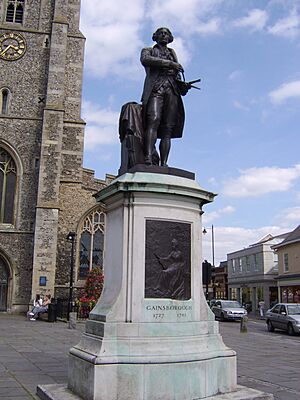
Sudbury's Famous Artists
In the 1700s, Sudbury became well-known for its artists. John Constable painted many scenes around the River Stour. The famous painter Thomas Gainsborough was born in Sudbury in 1727. He went to Sudbury Grammar School.
His birthplace is now called Gainsborough's House. It is a museum dedicated to his art and is open to the public. It has many of his valuable paintings and some of his family's belongings. A statue of Gainsborough was put up in the town centre in 1913, outside St Peter's Church.
Sudbury in Victorian Times and Beyond
In 1832, the villages of Ballingdon and Brundon became part of Sudbury. In 1841, Sudbury made history by electing David Ochterlony Dyce Sombre to Parliament. He was the first person from an ethnic minority to be elected in the UK. However, he was not allowed to take his seat.
A new workhouse, a place for poor people to live and work, was built in 1836. After 1946, it became the local hospital. Sudbury's Catholic Church, Our Lady Immaculate and St. John the Evangelist, was built in 1893.
During the Second World War, an American squadron of B-24 Liberator bombers was based at RAF Sudbury. These planes were famous for having colourful zodiac signs painted on them. Today, most of the old airfield buildings are gone.
In the mid-1960s, the Corn Exchange building was saved and turned into the local public library.
How Sudbury is Governed
In 1892, Sudbury became a municipal borough, which is a type of local government area. It was part of West Suffolk. The main office was at Sudbury Town Hall. In 1974, this local government area was changed to form Babergh.
Today, Sudbury has a 'Town Council' and a 'Town Mayor'. They look after the local area.
Sudbury's Parliament Members
From 1559 to 1844, Sudbury had two Members of Parliament (MPs). However, it lost this right in 1844 due to problems with corruption in elections. The Sudbury election of 1835 is thought to have inspired a famous election scene in Charles Dickens's novel Pickwick Papers.
A new area for electing one MP was created in 1885. This area was called Sudbury. It was later combined with other areas. Since 1983, Sudbury has been part of the South Suffolk area. The current MP is James Cartlidge from the Conservative Party.
Schools in Sudbury
Sudbury has one secondary school, called Ormiston Sudbury Academy. This school was formed in 1972 by combining three older schools.
There are also several primary schools in the town. These include Tudor CEVC Primary School, St. Gregory CEVCP, St Joseph's Roman Catholic Primary School, and Woodhall Primary School.
Media and News
Television signals for Sudbury come from the Sudbury TV transmitter.
The town has several radio stations. You can listen to BBC Radio Suffolk, BBC Essex, Heart East, Greatest Hits Radio East, Nation Radio Suffolk, and a local station called Karisco Radio.
Sudbury is served by a daily newspaper, the East Anglian Daily Times. There are also two weekly newspapers, the Sudbury Mercury and the Suffolk Free Press.
Sports and Activities
Sudbury has a popular football club, A.F.C. Sudbury. It was formed in 1999 by joining two older clubs. They play in a high league in English football.
The local rugby club, Sudbury R.F.C., plays in the London 2 North East league. Their ground is in the nearby village of Great Cornard. Sudbury Cricket Club is the town's oldest sports club, started in 1787. They play in the East Anglian Premier League.
The Kingfisher Leisure Centre has a 25-metre swimming pool, a sauna, a fitness centre, and a soft play area for children. It is home to Sudbury Storms Swimming Club.
Sudbury Rowing Club was founded in 1874. They have a boathouse by the Stour and hold a regatta (a series of boat races) every year.
Other sports groups in Sudbury include a canoeing club, a hapkido club, a running club, and a boxing club.
Culture and Fun in Sudbury
Sudbury was once a busy river port. The last industrial building by the river has been turned into the town's Quay Theatre. The River Stour Trust looks after the river and has a visitor centre. They offer boat trips on electric-powered boats.
Every September, a special event called Sudbury to the Sea takes place. Hundreds of canoe and small boat fans travel 24 miles (39 km) down the River Stour.
St Peter's Church, Sudbury is an old church in the town centre. It is now used for concerts, art shows, and markets. It is being restored to make it even better.
The Valley Walk is a path for cycling and walking. It starts at the Sudbury water meadows and follows an old railway track. It connects to the Melford Walk.
Since 2006, Sudbury has hosted the Leestock, a pop music festival that raises money for charity.
The children's author Dodie Smith lived near Sudbury. Part of her famous book The Hundred and One Dalmatians, which inspired the Disney film, takes place in the town. The dogs, Pongo and Perdita, pass through Sudbury on their journey: Just before midnight they came to the market town of Sudbury. Pongo paused as they crossed the bridge over the River Stour. "Here we enter Suffolk" he said, triumphantly. They ran on through the quiet streets of old houses and into the market square. They had hoped they might meet some dog and hear if any news of the puppies had come at the Twilight Barking, but not so much as a cat was stirring. While they were drinking at the fountain, church clocks began to strike midnight.
Getting Around Sudbury
Road and Bus Travel
Sudbury is connected by the A131 and A134 roads. The A131 runs from near Chelmsford, and the A134 goes through Bury St Edmunds. There is a taxi stand in Old Market Place. The bus station on Hamilton Road offers services to nearby places.
Train Travel
The railway came to Sudbury in 1847 when Sudbury railway station was built. Sudbury kept its train link to London, even when many other villages lost theirs. Sudbury railway station is now the end of a train line called the Gainsborough Line. This line stops at Bures and Chappel and Wakes Colne stations. It ends at Marks Tey railway station, where you can connect to trains going to London's Liverpool Street station.
River Transport in the Past
Sudbury used to be a port. From 1705, horse-drawn boats called lighters carried goods like grain, bricks, coal, and even coconuts on the river. Hay and straw were sent to London for horses. In return, horse manure was brought back for the fields. During World War I, 14 of these lighters were sunk to prevent German invasion. One of them was later rebuilt and now has an electric engine.
Sudbury's International Connections
The Canadian city of Greater Sudbury, Ontario, was named after Sudbury, Suffolk. It became a settlement in 1883. The person in charge of building the railway there, James Worthington, named it after his wife, Caroline Hitchcock, who was born in Sudbury, Suffolk.
Sudbury also has two namesakes in the New England region of the United States: Sudbury, Massachusetts, and Sudbury, Vermont.
Twin Towns
Sudbury is twinned with several towns in other countries. These are Höxter in Germany, Clermont in France, and Fredensborg in Denmark.
Famous People from Sudbury
- Simon Sudbury (c. 1316–1381), a very important leader who was Archbishop of Canterbury.
- Thomas Gainsborough (1727–1788), a world-famous painter of portraits and landscapes.
- Andrew Phillips, Baron Phillips of Sudbury (1939–2023), a lawyer, writer, and politician.
- Maggi Hambling (born 1945), a well-known artist.
- Stuart Slater (born 1969), a professional football player.
- Joel Willans (born 1972), an author and advertising expert.
- Amanda Ansell (born 1976), an artist.
Other famous people who worked or lived near Sudbury include:
- John Constable (1776–1837), another famous landscape painter.
- Adrian Bell (1901–1980), a journalist and farmer.
- Jack Bruce (1943–2014), the lead singer and bassist of the rock band Cream.
Images for kids
See also
 In Spanish: Sudbury (Suffolk) para niños
In Spanish: Sudbury (Suffolk) para niños


